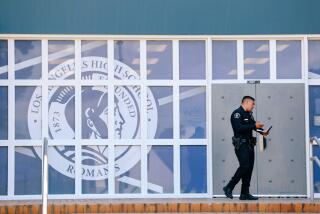Researchers Diagnose a Phase : Accident-Prone Youngsters Confirmed
- Share via
CHICAGO — The accident-prone youngster really seems to exist, say researchers who studied more than 50,000 schoolchildren and found that some got hurt more often than would be expected.
Accident-proneness usually appeared to be a phase, rather than a long-term characteristic, suggesting that it might be possible to identify the periods of increased risk and stop injuries before they happen, the researchers said.
They studied 54,874 children ages 6 to 18 over a three-year period in a Tucson school district. They found 8,429 injuries during school hours that were serious enough to require a doctor’s attention, cause school absence or restrict sports participation.
Seventeen percent of the injuries occurred to 1% of the children, a significantly higher rate than could be expected from chance alone, the researchers said in the March issue of the American Journal of Diseases of Children.
There were 574 children who got two or more injuries in a single year, but few of them kept getting injured over and over again, the researchers said.
“Most sustained only two injuries, and the vast majority of injuries were clustered within a short time,” said the researchers, Dr. W. Thomas Boyce of UC San Francisco and Sue Sobolewski of the Tucson Unified School District.
Injuries were most likely to recur among junior high school boys, children engaged in athletic activities and youngsters attending schools with longer hours or who were engaged in such alternative programs as “open” classrooms or “magnet” schools, the researchers said.
“Only an extraordinarily small group of children--perhaps as few as three in 10,000--seem to maintain an inordinate risk of injury over an extended period of years,” the researchers said.
The study did not cover why some children seemed to have clusters of injuries, but the researchers theorized that such stresses as family or social problems, or the onset of adolescence, could cause the temporary accident-proneness. More study could lead to ways to prevent accidents in such children, they said.
Dr. Mark Widome, chairman of the Committee on Accident and Poison Prevention for the American Academy of Pediatrics, commended the research, saying, “This is a study people are going to quote for a while.”




